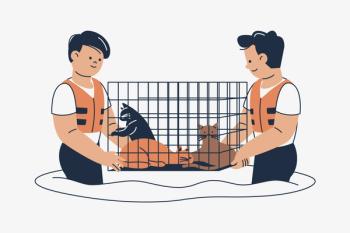
Calm skies ahead: Helping pets with thunderstorm phobias
CVC educator Dr. ELise Christensen, DACVB, offers at-home behavior modification strategies veterinarians and team members can offer to clients.
Getty Images
Thunderstorm phobia is a panic disorder commonly seen in adult dogs in which the trigger is associated with a storm. The panic lasts the duration of the storm and often after anywhere from 30 minutes to days. There is often anticipation of the storm before it happens. Thunderstorm phobias cause suffering to patient and family, and, if left untreated, can worsen over time. This negatively impacts the patient's welfare and increases its chance of being abandoned, abused, rehomed or euthanized, says E'Lise Christensen, DVM, DACVB, at a recent
Once a patient has been started on the proper medication for its phobia, which could include trigger-time medication or daily medication, the treatment plan shouldn't stop there, according to Dr. Christensen. Behavior modification should be implemented in the home as well to help keep the animal feeling safe. Use these strategies to help your clients manage a thunderstorm phobia:
Create a storm bunker
The first thing clients should do is create a safe space or “storm bunker” for the pet to rest during storms or perceived triggers. These spaces are defined by the patient's own preferences but could be a windowless room or a room with curtains or blinds over the windows in an interior part of the home's floorplan or in the basement. When given the choice, many dogs choose closets, bathrooms or their crates as safe spaces, Dr. Christensen says. Playing classical music or using a white noise machine can help drown out some outside noises as well.
Develop a non-storm routine
On non-storm days, behavior modification should be worked on for at least five minutes a day. This process includes desensitization and counterconditioning for each of the patient's individual triggers and relaxation coaching, which includes use of the storm bunker. If your veterinary team is new to behavior or doesn't have the time to do in-depth behavioral counseling with veterinary clients, Dr. Christensen says you can recommend noise desensitization and counterconditioning audio packages to clients that include structured behavior modification plans. Relaxation and massage work can also improve the patient's baseline anxiety levels and increase its ability to tolerate trigger situations in the long term, she says.
Try different tools
Anti-anxiety aids like body wraps, Thundershirts, caps, goggles, headphones and earplugs are available to help lessen trigger intensity, but remember that efficacy is dependent on the patient, Dr. Christensen says. One study has shown significant improvement in patients that wore a body wrap during thunderstorms.1 Pheromone diffusers have also been shown to decrease fear and anxiety scores in laboratory models.2
Send in the supplements
There are a number of supplements you can try, but don't use them as the cornerstone of treatment for thunderstorm phobia. Supplements should be used in conjunction with psychoactive medications, behavior modification and management for the best outcome. Dr. Christensen's words of warning: Always source these medications and supplements from veterinary-specific providers who have researched the supplements they sell and ensure consistency of their products-or at the very least are sensitive to reaching out for veterinary insight, criticism and support.
She uses a variety of supplements and adjunctive therapies to treat storm phobias.
References:
1. Cottam N, Dodman N, Ha J. The effectiveness of the Anxiety Wrap in the treatment of canine thunderstorm phobia: An open-label trial. J Vet Behav. 2013;8(3)154–161.
2. Landsberg GM, Beck A, Lopez A, et al. Dog-appeasing pheromone collars reduce sound-induced fear and anxiety in beagle dogs: A placebo-controlled study. Vet Rec. 2015;177(10)260.
Newsletter
From exam room tips to practice management insights, get trusted veterinary news delivered straight to your inbox—subscribe to dvm360.





